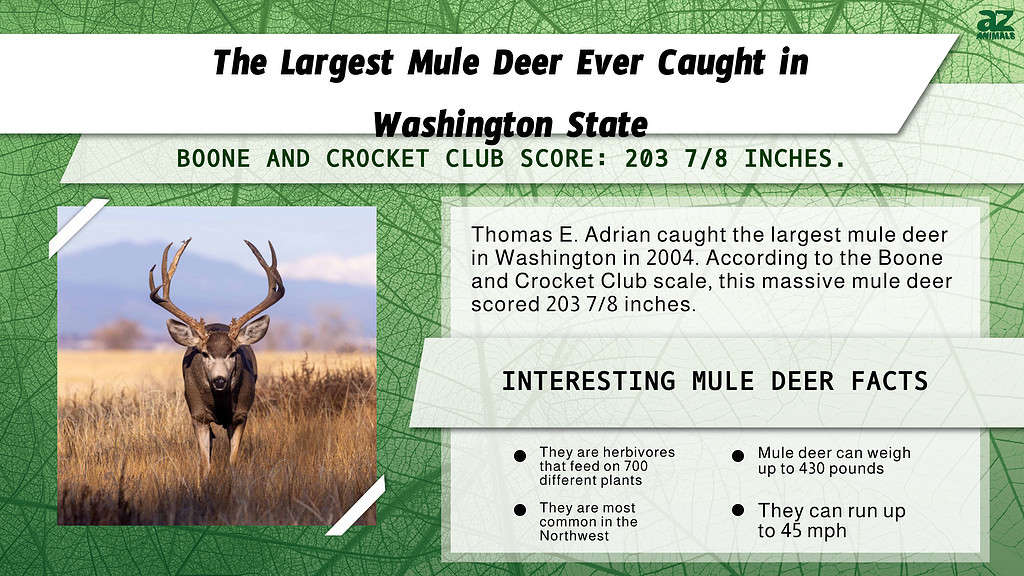Mule deer are impressive animals that weigh over 300 pounds. They are popular animals for hunting, especially in Washington state. These large deer are very common in Washington, just like black-tailed deer and white-tailed deer. Can you guess the size of the largest mule deer ever caught in Washington? Follow along to find out!

The Largest Mule Deer Ever Caught in Washington
Thomas E. Adrian caught the largest mule deer in Washington in 2004. According to the Boone and Crocket Club scale, this massive mule deer scored 203 7/8 inches. Another record mule deer reigns in Washington state. In 1943, over 80 years ago, Ray Grow caught and killed a non-typical mule deer scoring 283 4/8 inches. While many people have caught jaw-dropping mule deer, they haven’t come close to beating either score.

In 2004, Thomas E. Adrain caught the largest mule deer in Washington.
©iStock.com/Tiago_Fernandez
About Mule Deer
Mule deer are large mammals in the Capreolinae subfamily and Odocoileus genus. Its scientific name is Odocoileus hemionus. Currently, the International Union for Conservation of Nature lists this species as Least Concern. Scientists are still researching and learning about these animals. According to some, there are 10 subspecies.

According to the International Union for Conservation of Nature, mule deer are Least Concern.
©iStock.com/Kerry Hargrove
Size and Appearance
Mule deer vary in appearance depending on the subspecies. They are about 3 to 3.5 feet tall and between 4.5 to 7 feet long. Mule deer are best known for their large ears. They are sometimes nearly three-fourths the length of their heads. Mule deer are brown, grey, and white with a black mask over their face. Their coat’s color ranges though and changes with each season. The coats are darker in winter, and lighter in summer, which helps them hide from predators. They camouflage against trees.
Mule deer also have a white rump and tail with black tips. Apart from their ears, you can tell whitetail deer and mule deer apart because whitetail deer have white tips. Most mule deer weigh between 130 and 280 pounds. However, they can weigh as much as 431 pounds. The recorded 431-pound mule deer may have weighed more than 540 pounds alive.
Diet
These large deer are herbivores and consume many different types of plants. They are foragers that change what they eat depending on the season. For example, in the winter, most of the mule deer’s diet is shrubs and trees. However, by summer and fall, mule deer eat more forbs. Grass and grass-like plants are more commonly consumed in winter and spring.
Mule deer aren’t picky. Experts have recorded mule deer feeding on over 700 plants. The exact plants depend on the region. However, the most commonly eaten trees and shrubs are quaking aspens, Mexican cliffroses, Gambel oaks, and big sage bushes. Mule deer also eat Louisiana sagewort, creek dogwood, jack pine, wild oat, wild cherry, and sunflower.
Distribution and Habitat
Where can you find mule deer? This deer species is native to North America and South America. They are more common in the Northwest. Some states you may find mule deer include Arizona, Washington, Alaska, Colorado, and Washington. They aren’t picky animals and live in different environments. They can live in thick forests, grasslands, rocky mountains, and semi-deserts. In Washington, you can find these deer in open forests. Every subspecies though has a unique range. For instance, the Cedros/Cerros Island mule deer lives on Cedros Island. The Inyo mule deer lives within the Sierra Nevada mountain range in California.
Behaviors
Mule deer have interesting behaviors. They are highly social animals known for staying together in multi-generational groups. Mule deer typically live in groups of females. Bucks, male deer, leave their familiar groups and live independently. Sometimes, they join with other bucks to create a small group, which helps them get away from predators. Their predators are more likely to hunt down individual mule deer as opposed to a group. Males in mating season are competitive and the ones with the largest antlers fight against other males and win.
Predators
The most common mule deer predator is the human. However, they are also hunted down by coyotes, mountain lions, black bears, bobcats, and grizzly bears. However, young mule deer, also called fawns, are more at risk. Adult mule deer are fast and have keen senses. They can run up to 45 mph in short bursts.
The Largest Mule Deer Ever Caught
Did you know that the largest mule deer ever caught in the world was shot in 1926? For nearly a century, Edmund Broder has held this impressive world record. On that day, Edmund, also known as Ed, went with two friends to hunt near Edmonton, Alberta in Chip Lake. Ed spotted deer tracks and followed them around 1 PM. Using a .32 Winchester Special, he shot a massive mule deer. It scored 355 2/8 inches.
The photo featured at the top of this post is © iStock.com/Kerry Hargrove
Thank you for reading! Have some feedback for us? Contact the AZ Animals editorial team.







